Structural Inorganic Chemistry Laboratory: Pioneering Materials Science through Understanding Synthesis, Structure, and Properties
Our laboratory aims to efficiently create innovative functional inorganic materials by elucidating the intricate relationship between **”synthesis, structure, and properties,”** merging intellectual curiosity with cutting-edge technology. We explore the potential of yet-undiscovered materials, driven by a relentless curiosity to “find more and faster” With this spirit, we are pioneering the frontiers of materials science that will underpin the society of the future.
We provide a state-of-the-art research environment, offering unique learning and challenging opportunities for students and young researchers. We are also dedicated to fostering the next generation of leaders equipped with specialized skills and international communication abilities.
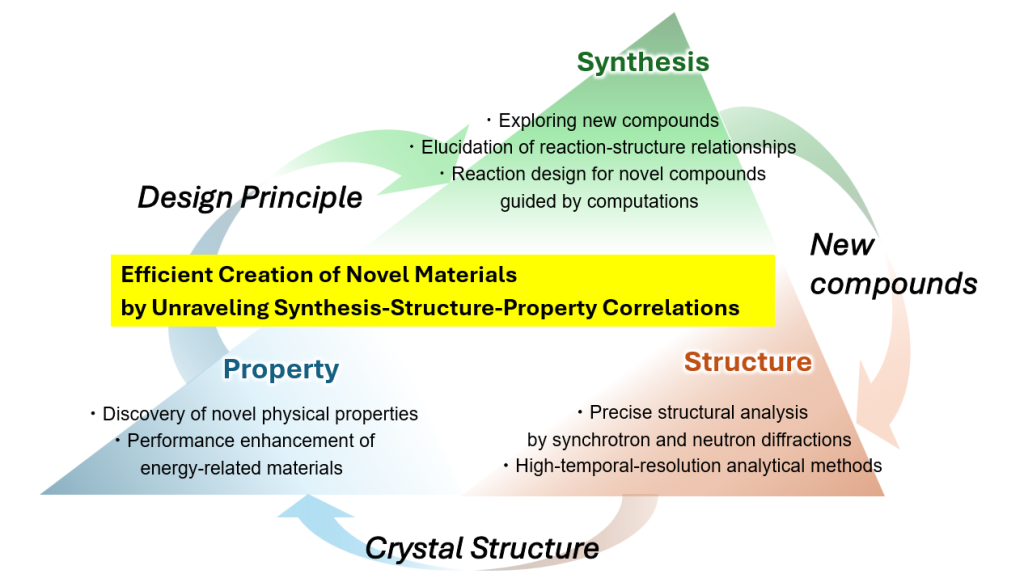
1. Synthesis of Novel Compounds through Reaction Control: Designing Synthesis for Efficient Materials Creation
In the creation of new functional materials, we focus on the synthesis of novel compounds, which serves as the “starting point.” Moving beyond traditional synthesis reliant on experience and intuition, we aim to establish more rational and efficient synthetic routes by integrating computational science and in situ analysis.
Synthesis of Novel Compounds and Establishment of Synthetic Routes
The advancement of chemistry has long been driven by the exploration of unknown substances, fueled by intellectual curiosity. We are passionate about discovering new structures with exciting properties that emerge from combining the diverse elements of the periodic table. In particular, we focus on non-oxide anions (e.g., N³⁻, NCN²⁻, S²⁻, Cl⁻), exploring the potential for unpredictable physical properties arising from their unique charges, sizes, and shapes. (Examples: perovskite-type oxynitrides, novel chlorides, carbodiimides, etc.)
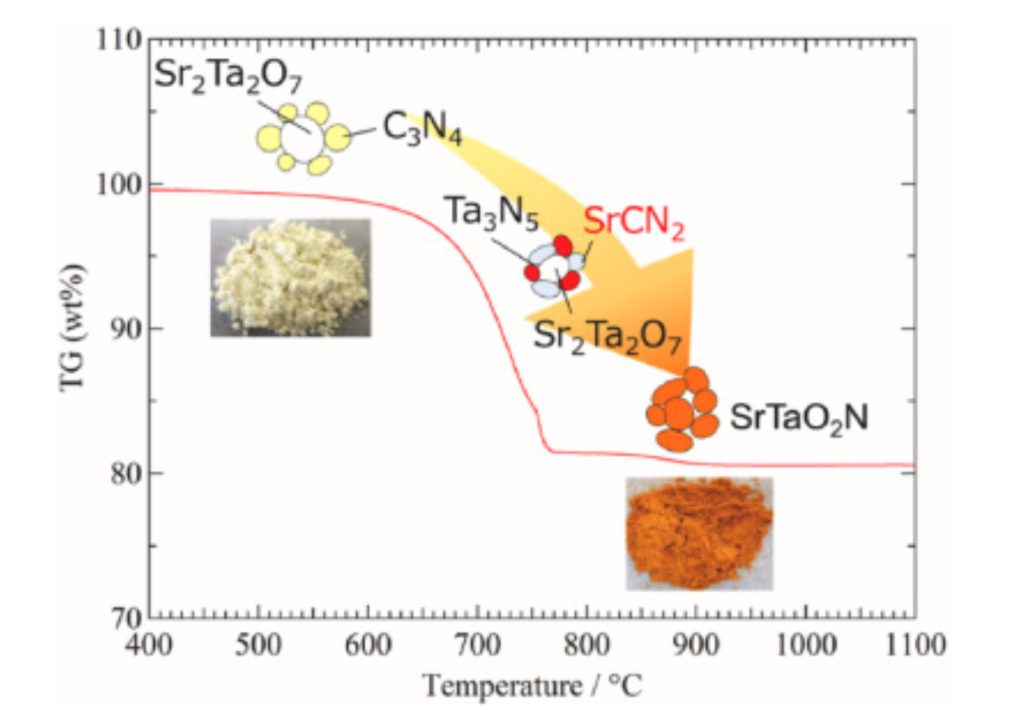
Novel synthetic approaches and morphological design of perovskite-type oxynitrides in powder and ceramic form
Yuji Masubuchi
Progress in Solid State Chemistry, 73, 100411, March 2024.
Link:https://doi.org/10.1016/j.progsolidstchem.2024.100440
Elucidating Reaction-Structure Relationships with In Situ Measurements
The material synthesis process has often been a “black box” of complex, intertwined factors. We utilize cutting-edge in situ analysis techniques, such as synchrotron X-ray diffraction and in situ electron microscopy, to track phase transitions, changes in crystal structure, and particle growth and morphology in real time during heating and reactions. This allows us to “visualize” the reaction pathways and rate-determining steps in processes like solid-state synthesis and mechanochemical synthesis (e.g., ball milling) in detail, deepening our fundamental understanding of synthesis mechanisms.
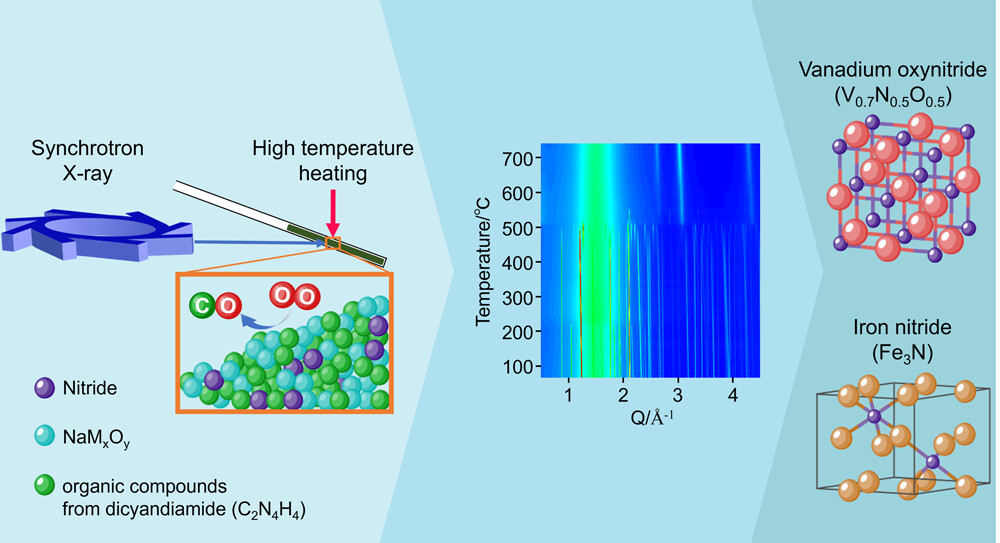
Rapid In Situ Investigation of Nitride Synthesis: Ambient Atmospheric Nitridation of 3d Metal Oxides Using Dicyandiamide
M Demura, K Ono, M Nagao, T Yamamoto, CH Lee, A Yamashita, Y Masubuchi, K Tadanaga, A Miura
Chemistry of Materials, 36(23), 11490-11498, 2024.
Link:https://doi.org/10.1021/acs.chemmater.4c02137
Reaction Design for Novel Compounds Based on Large-Scale Computation
By actively incorporating computational science, particularly AI (machine learning) and first-principles calculations, we aim to dramatically improve the efficiency of materials discovery and find optimal materials more rapidly. Beyond estimating the thermodynamic driving force from reactants to products, we predict and design synthesis reactions through large-scale simulations, paving the way for the rational creation of targeted materials.
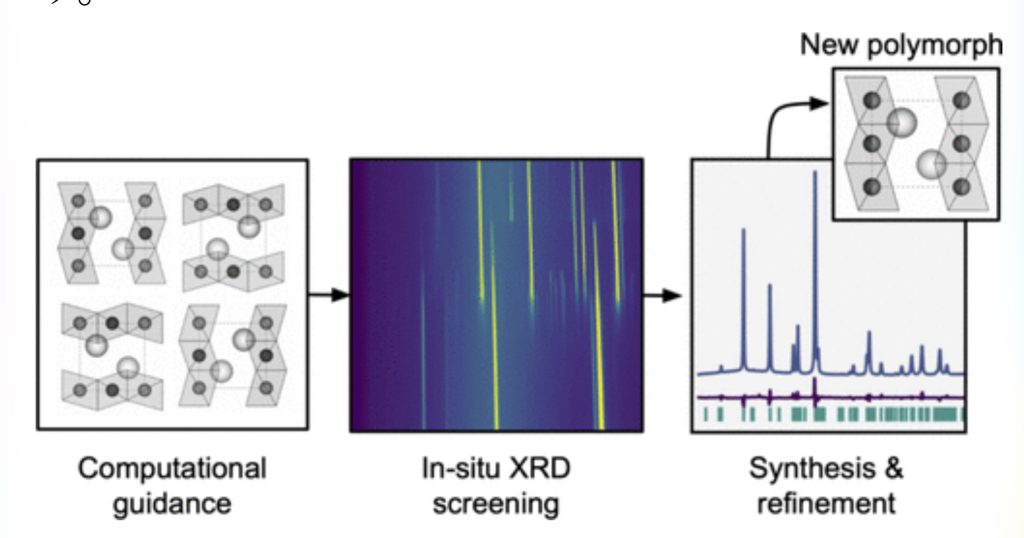
Efficient Exploratory Synthesis of Quaternary Cesium Chlorides Guided by In Silico Predictions
Akira Miura, Muratahan Aykol, Shumma Kozaki, Chikako Moriyoshi, Shintaro Kobayashi, Shogo Kawaguchi, Chul-Ho Lee, Yongming Wang, Amil Merchan, Simon Batzner, Hiroshi Kageyama, Kiyoharu Tadanaga, Pushmeet Kohli, Ekin Dogus Cubuk
Journal of the American Chemical Society, 146(43) 29637-29644, Oct 16, 2024.
(Featured in press releases, Nikkei, Science Japan, and The Atlantic)
Link: https://doi.org/10.1021/jacs.4c10294
—
2. Structure Determination for Understanding Synthesis and Properties: Exploring the Nature of Materials with Advanced Analysis
A material’s function is deeply rooted in its internal atomic arrangement—its “structure.” By precisely analyzing the structure of newly synthesized materials or unstable intermediate phases, we aim to gain insights into the mechanisms of functional expression and develop guidelines for more efficient synthesis methods.
Crystal Structure Analysis
In addition to crystal structure analysis based on X-ray and electron diffraction, we conduct advanced structural analysis using large-scale synchrotron radiation and neutron facilities, employing techniques like **synchrotron X-ray and neutron diffraction**. Using pair distribution function (PDF) analysis, we can reveal local structural disorders invisible in the average structure, thereby uncovering the hidden potential of materials. We combine the latest analytical techniques and computational methods to solve complex structures.
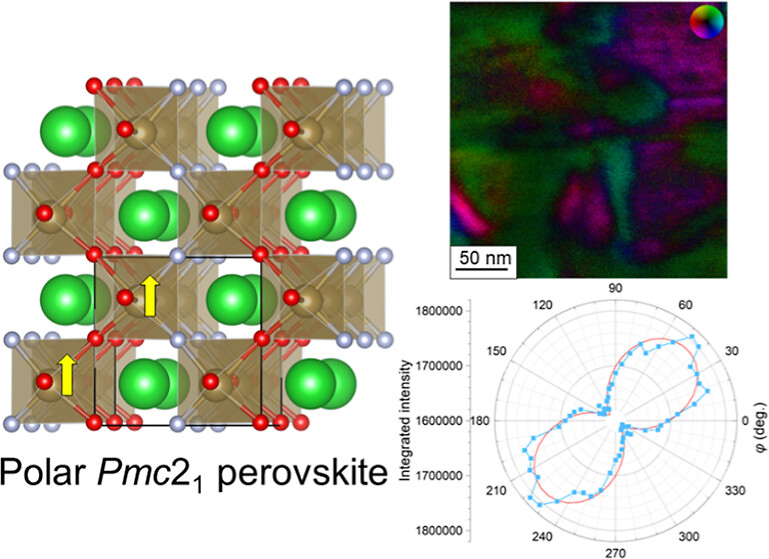
Average Cubic BaTaO2N Crystal Structure Formed by 50 nm Size Domains with Polar Nanoregions Consisting of cis-TaO4N2 Octahedral Chains
Yuji Masubuchi, Kyohei Koyama, Akira Hosono, Mikio Higuchi, Masaki Takesada, Kazuki Shitara, Hiroki Moriwake, Shinichi Kikkawa
Chem. Mater.* 2024, 36, 15, 7504–7513
Link: https://pubs.acs.org/doi/10.1021/acs.chemmater.4c01474
Development of High-Temporal-Resolution Analysis Methods
Beyond real-time tracking of synthesis reactions, we are developing and applying new analytical methods that push the limits of temporal resolution, such as high-temporal-resolution XRD and pair distribution function analysis, to capture structural changes that occur over short timescales during phase transitions and property changes. This allows us to clarify not only thermodynamic stability but also kinetic stability and the mechanisms of structural change.
3. Creation of Novel Materials through Functional Design: Discovering and Applying Properties Beyond Prediction
Building on the knowledge gained from synthesis and structural analysis, we create materials with new functionalities and advance research toward their societal implementation. We particularly focus on discovering “unexpected properties” that defy conventional wisdom and elucidating their underlying mechanisms.
Discovery of Novel Physical Properties and Characteristics
Driven by intellectual curiosity and sharp experimental observation, we discover previously unknown physical properties and characteristics. For instance, we elucidate mechanisms where physical stimuli dramatically alter material properties—such as the phenomenon where a simple mechanical action like “hand milling” induces a phase transition, or the stress-induced martensitic transformation in chlorides—and propose new concepts in materials science. We are also exploring and applying a wide range of unique functional materials, including those with negative thermal expansion and materials whose properties are linked to their extreme softness.
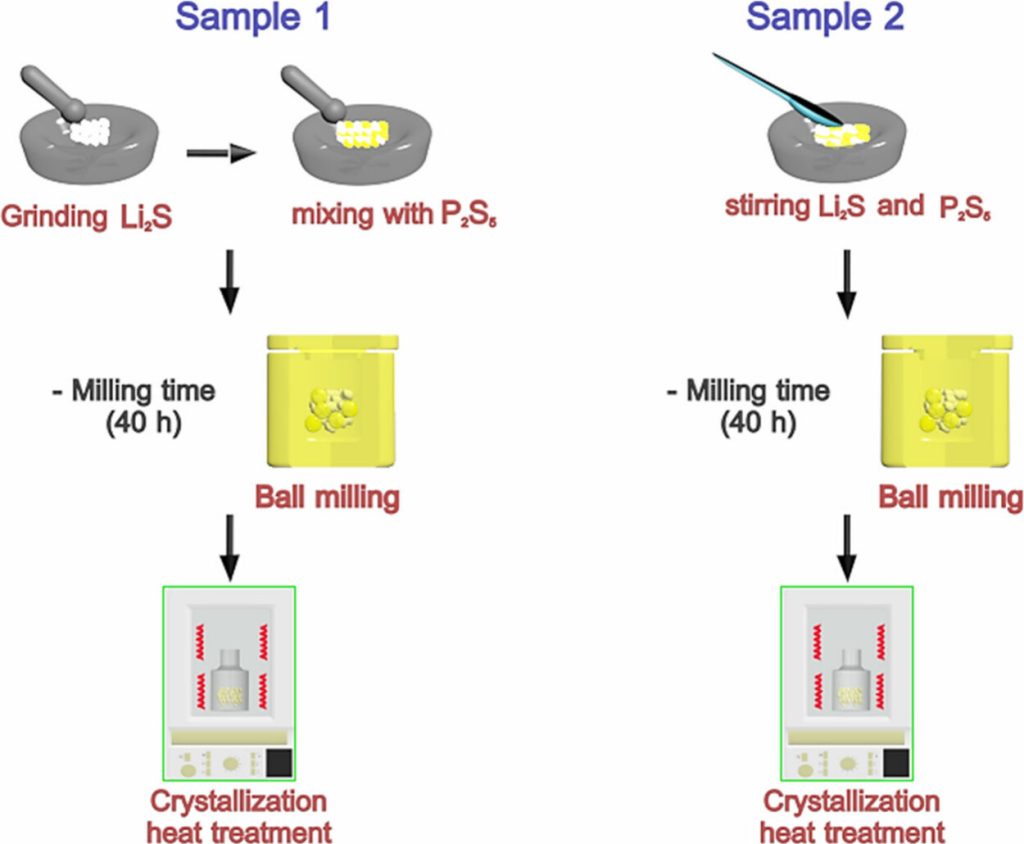
Hand Milling Induced Phase Transition for Marcasite-type Carbodiimide
Yuzuki Yamamoto, Kazuki Kume, Suzuka Miyazaki, Ayako Shinozaki, Peng Song, Sayed Sahriar Hasan, Kenta Hongo, Ryo Maezono, Hiroki Ubukata, Hiroshi Kageyama, Mikio Higuchi, Yuji Masubuchi
*Journal of the American Chemical Society*, 147(26), 11390–11398, Jul 3, 2024.
Link: https://pubs.acs.org/doi/10.1021/jacs.5c00962
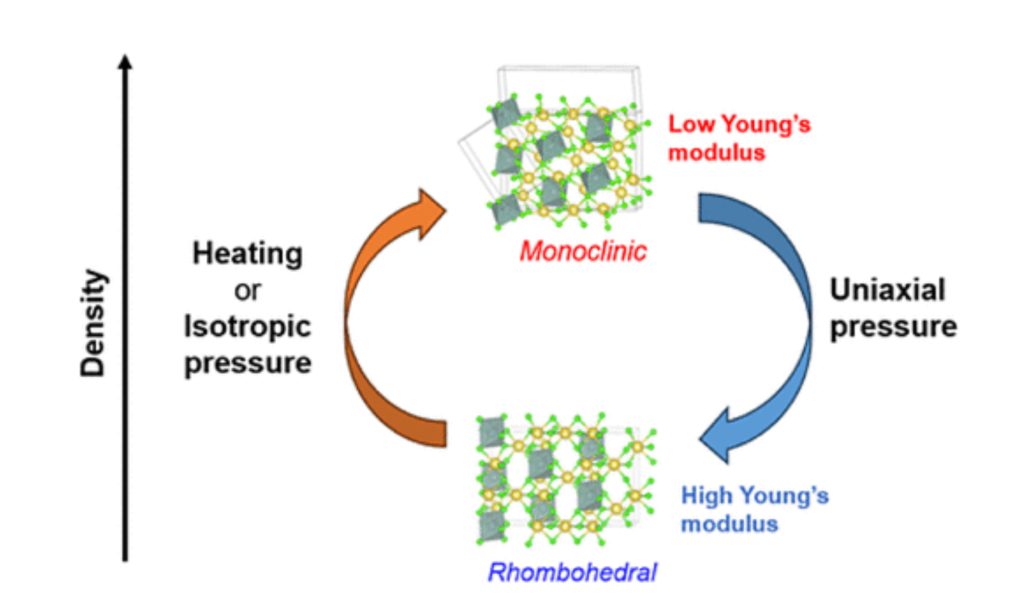
Stress-Induced Martensitic Transformation in Na3YCl6
Akira Miura, Koki Muraoka, Kotaro Maki, Saori Kawaguchi, Kazuhiro Hikima, Hiroyuki Muto, Atsunori Matsuda, Ichiro Yamane, Toshihiro Shimada, Hiroaki Ito, Yoshikazu Mizuguchi, Chikako Moriyoshi, Hiroshi Nakajima, Shigeo Mori, Hiroshi Oike, Akira Nakayama, Wenhao Sun, Nataly Carolina Rosero-Navarro, Kiyoharu Tadanaga
*Journal of the American Chemical Society*, 146(36), 25263-25269, Sep 11, 2024.
(Featured in press releases and Nikkei)
Link: https://doi.org/10.1021/jacs.4c09476
Enhancement of Material Performance
Energy materials such as lithium-ion batteries, fuel cells, and catalysts are crucial for achieving a sustainable society. With specific applications in mind, we work to dramatically improve the performance of existing materials by optimizing synthesis methods and structural designs.
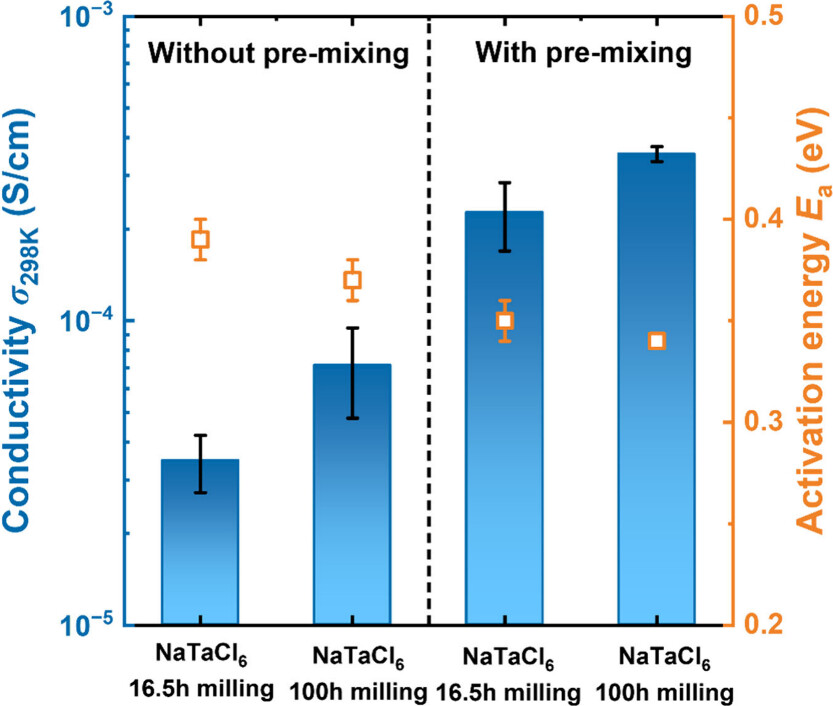
The Detail Matters: Unveiling Overlooked Parameters in the Mechanochemical Synthesis of Solid Electrolytes
Abdulkadir Kızılaslan, Mustafa Çelik, Yuta Fujii, Zheng Huang, Chikako Moriyoshi, Shogo Kawaguchi, Satoshi Hiroi, Koji Ohara, Mariko Ando, Kiyoharu Tadanaga, Saneyuki Ohno, Akira Miura
*ACS Energy Letters*, 10(1), 156-160, 2025.
Link: https://doi.org/10.1021/acsenergylett.4c02156
Collaborations and International Partnerships
Our research is supported by close collaborations with various universities, research institutions, and industrial partners, both in Japan and internationally. We have established strong cooperative relationships with top-level researchers and companies worldwide, especially in the areas of detailed average and local structure analysis using synchrotron and neutron facilities, as well as materials design and property prediction using first-principles calculations and machine learning. Through this open collaborative framework, we are accelerating new discoveries and innovations.
—
At the Structural Inorganic Chemistry Laboratory, we continuously challenge ourselves to create functional inorganic materials that will shape the future, by merging intellectual curiosity with the latest science and technology.
